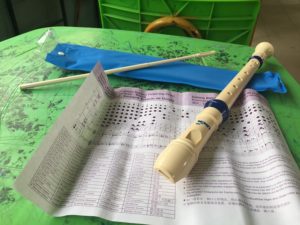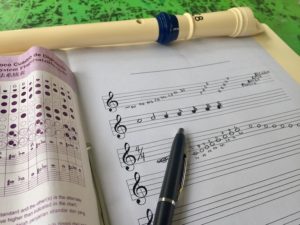

In a school that just lost it’s music teacher, Trifecta Arts is beginning a new program to teach interested students the fundamentals of music. Francisco Huerta Rendon School in Salinas, Ecuador had a music program that consisted of glockenspiels and snare drums. It was limited to the older students and had to be discontinued when the music teacher was transferred to a school in a larger city, in the middle of the school year.
We are starting with a different approach (following the model of many elementary schools in the United States) and using the simple recorder to teach reading music and group performance skills. The classes are being taught by two local musicians, David Moises Murillo Lima and Mauro Andres Murillo Lima. David and Mauro both have performance experience, but this is their first assignment teaching a group of 2nd – 6th graders. We have two groups with a total of 40 students for this session with will run for 4 weeks with 2 classes per group per week. At the end of the session, we hope to have a brief performance to allow the students to gain public performance experience.
As I sit in on the classes, it is very interesting that they use the “Doe-Ray-Me” scale with Spanish spellings instead of the “A-G” scale used in the United States. So, instead of learning the notes by memorizing F-A-C-E for the spaces and E-G-B-D-F (Every Good Boy Does Fine) for the lines of the staff, the children are memorizing “Do-Re-Mi-Fa-So-La-Si-Do.” (No, Julie Andrews, I don’t know what they did with the “Tea!”)
The cultural differences continue with the names of the notes… Whole note = Redondo (Round), Half note = Blanco (White), Quarter note = Negro (Black). And while these names are certainly descriptive of the symbol, it doesn’t really relate to the length of the note relative to the time signature. Any music teachers out there ever run into this?
It’s all very confusing to me, so I think I’ll stick with the way I learned it in 6th grade with my second-hand Bundy Flute.
Stay tuned for future updates and visit the Initiative Page (Click here) to learn more and make a donation to support this program!


